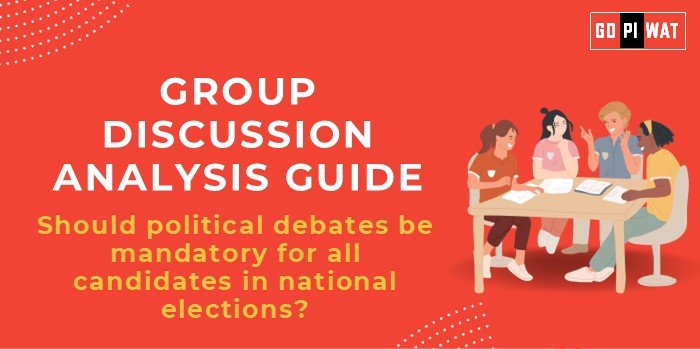📋 Group Discussion (GD) Analysis Guide
Should political debates be mandatory for all candidates in national elections?
🌐 Introduction to the Topic
- Opening Context: Political debates serve as a cornerstone of democratic transparency, fostering informed decision-making among voters.
- Topic Background: First televised political debates began in the U.S. during the 1960s, revolutionizing electoral campaigns. In India, debates are sporadic, primarily limited to party leaders, leaving a gap in voter engagement at the constituency level.
📊 Quick Facts and Key Statistics
- 2024 Lok Sabha Constituencies: 543 constituencies across India highlight the need for better candidate outreach.
- Debate Participation: Only 30% of global democracies mandate political debates.
- Voter Turnout Impact: Studies indicate debates can increase voter turnout by 10-12%.
- Cost of Campaigns in India: Over ₹60,000 crore spent in the 2019 elections, highlighting the need for transparent communication.
👥 Stakeholders and Their Roles
- Election Commission of India (ECI): Regulates electoral procedures and ensures equal representation.
- Political Candidates: Directly communicate their agenda, policies, and qualifications.
- Voters: Gain clarity to make informed choices.
- Media: Serve as facilitators for debate moderation and public dissemination.
✨ Achievements and Challenges
Achievements
- Enhanced transparency in countries like the U.S. where debates hold leaders accountable.
- Youth engagement through platforms like social media, which broadcast debates to younger demographics.
- Increased focus on policy over populism in countries like South Korea.
Challenges
- Logistics of hosting debates for 500+ constituencies.
- Media bias potentially undermining neutrality.
- Public disinterest, as seen in the U.K., despite mandatory debates.
📚 Case Studies
- Kerala’s Grassroots Debates: Increased voter turnout by 15% during municipal elections.
- Canada’s Debate Commission: Ensures fairness and accessibility through standardized formats.
🗣️ Structured Arguments for Discussion
- Supporting Stance: “Mandatory debates ensure transparency and equal opportunity for candidates to present their visions.”
- Opposing Stance: “Debates could disadvantage grassroots candidates due to lack of resources for preparation.”
- Balanced Perspective: “While debates improve voter awareness, they must be complemented with accessible formats and regional considerations.”
📈 Effective Discussion Approaches
- Opening Approaches:
- Highlight voter engagement statistics in countries with mandatory debates.
- Use historical examples, such as Kennedy-Nixon’s 1960 debate, to emphasize impact.
- Counter-Argument Handling: Acknowledge logistical challenges but propose scalable solutions like regional debate telecasts.
📋 Strategic Analysis of Strengths and Weaknesses
- Strengths: Enhances voter education, strengthens democratic institutions.
- Weaknesses: Media bias and logistical hurdles.
- Opportunities: Public-private collaborations to streamline debates.
- Threats: Risk of polarization and misinformation during debates.
📌 Connecting with B-School Applications
- Real-World Applications: Discuss the role of debates in decision-making processes and strategic communication.
- Sample Questions:
- “What role does transparency play in modern governance?”
- “Can debates mitigate the rise of populism in politics?”
- Insights for B-School Students: Learnings from political debate formats can influence leadership and presentation skills in corporate settings.


